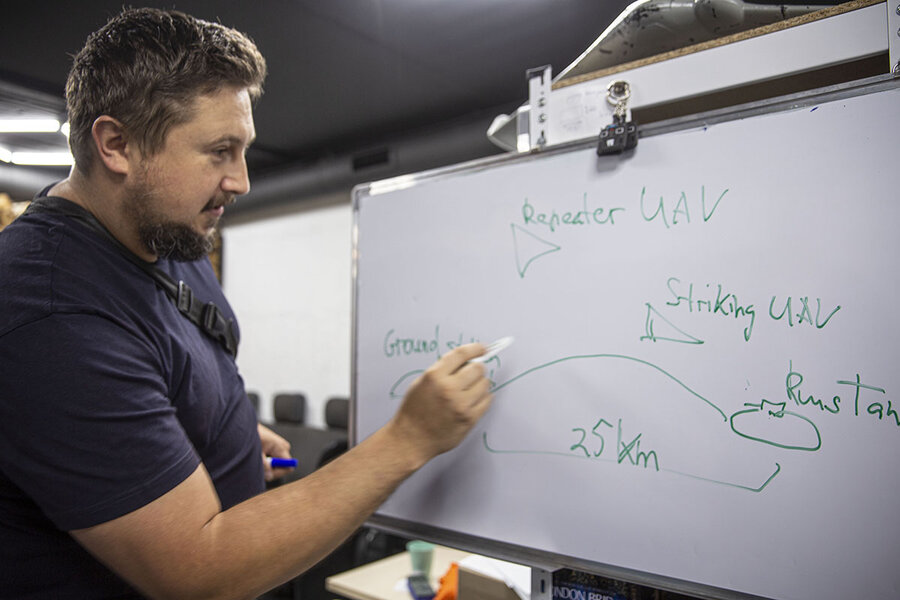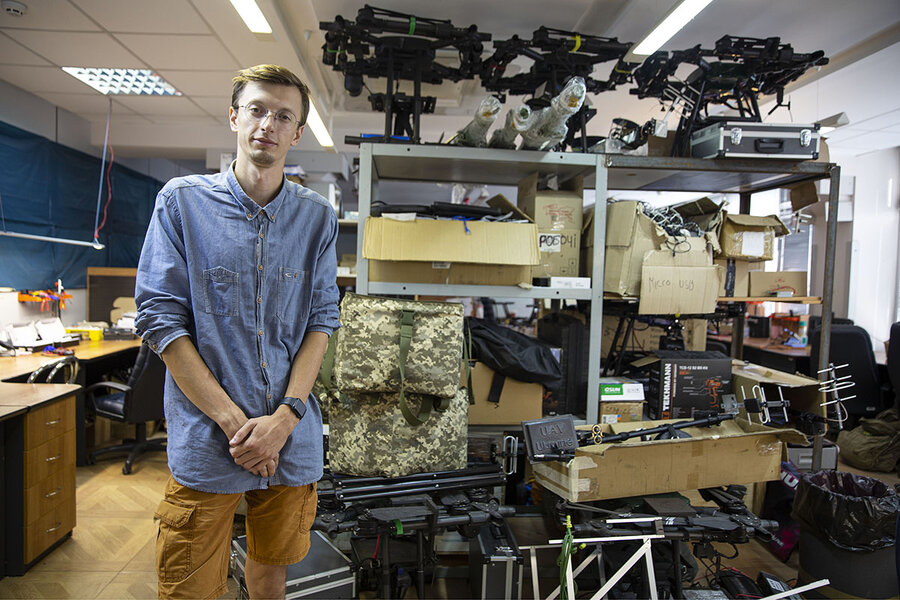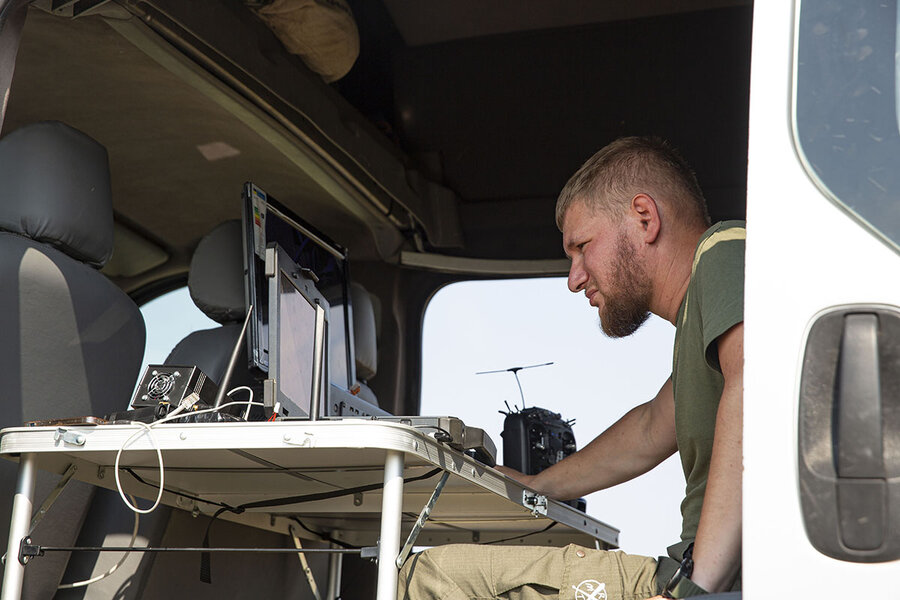War on a budget: Ukraine becomes hotbed for drone tech
Loading...
| Lviv, Ukraine
As Ukraine defends itself against Russia, its drone industry is booming.
A new generation of Ukrainians has had its imagination captured by the beauty and logic of uncrewed aerial vehicles, and been inspired to manufacture drones. Many of them hail from a business and engineering, rather than a military, background. Others are former video gamers who found their groove in military technology. The cost of war fills them all with the same sense of urgency.
Why We Wrote This
A story focused onThe need to protect the homeland and prevail over invader Russia has turned Ukraine into a hotbed for new drone technology, attracting engineers both foreign and domestic.
Ukraine has become a giant testing ground for drones from all over the world – the United States, Germany, Poland, and other partner countries. Countless new companies are taking shape around the technology; teams of engineers are tinkering on prototypes, trying to clear the Ministry of Defense and NATO checklists of technical requirements, hoping to nail a military contract.
“They come to Ukraine to understand if a drone is a real combat drone,” says Maxim Sheremet, leader of drone manufacturer Dronarnia. “It is not the same as killing in Iraq using powerful UAV drones,” he adds. “In Ukraine, war became not on the front lines but in our minds. You need technology.”
Ukrainian aviator Roman Schemechko loved building model airplanes as a child. Russia’s war on Ukraine has given him an unfortunate pretext to revisit that passion.
Prototypes of attack and surveillance drones built by his company, Besomar (White Demon), fill a spacious room in a bare-bones office building in Lviv.
“Drones save lives,” says Mr. Schemechko, now the CEO. “The more drones we have, the more possibilities we have to strike the enemy.”
Why We Wrote This
A story focused onThe need to protect the homeland and prevail over invader Russia has turned Ukraine into a hotbed for new drone technology, attracting engineers both foreign and domestic.
The drone industry in Ukraine is booming. A new generation of Ukrainians has had its imagination captured by the beauty and logic of uncrewed aerial vehicles, and been inspired to manufacture drones. Many of them hail from a business and engineering, rather than a military, background. Others are former video gamers who found their groove in military technology. The cost of war fills them all with the same sense of urgency.
Ukraine has become a giant testing ground for drones from all over the world - the United States, Germany, Poland, and other partner countries. Countless new companies are taking shape around the technology; teams of engineers are tinkering on prototypes, trying to clear the Ministry of Defense and NATO checklists of technical requirements, hoping to nail a military contract.
“They come to Ukraine to understand if a drone is a real combat drone,” says Maxim Sheremet, leader of drone manufacturer Dronarnia. “It is not the same as killing in Iraq using powerful UAV drones,” he adds. “In Ukraine, war became not on the front lines but in our minds. You need technology.”
A booming field
Drones became part of Ukrainian defense capabilities against Russia in 2014, when Moscow annexed Crimea and part of eastern Ukraine. They provide many advantages in asymmetric warfare, with low cost and reduced risk to military personnel atop the list. They can be used for surveillance, reconnaissance, and precision strikes without the investment associated with crewed aircraft. Even the most expensive model is several orders of magnitude cheaper than an F-16, and relatively basic ones can carry enough explosives to take down a tank.
“Drones can be more effective in surveillance than a human pilot on the plane,” points out Mr. Schemechko. “You can fly safely and not be afraid for your life. ... One person can produce many drones that can be used to drop bombs or spy on the enemy. In contrast, it requires a lot of time to train a pilot. You need two to three months to produce a pilot with a decent level of knowledge and skill.”
Drones – unlike pilots – are also easier to replace. “When a drone is destroyed and lost, a drone pilot can take a new one and keep going.”
The intensity of drone warfare between Russia and Ukraine is pushing both sides to fine-tune the full spectrum of related technologies and combat strategies.
In a cavernous room in Kyiv that echoes with the whizzing of small drones taking off and crashing into safety nets, one group of aspiring operators is learning such techniques.
Kyrylo, an athletic man with a square jaw who sports virtual reality goggles, manipulates a remote controller linked to a first-person view (FPV) drone. He is training to pilot through the perspective of the drone’s onboard camera.
“There are a lot of people in infantry who want to transfer to the drone operator units because they think that it’s easier or because they’re afraid of shelling,” says Kyrylo, who was taking a break from his front-line position in the Donetsk region to take part in a drone flight course in Kyiv. “They just don’t realize that this position and this job is very dangerous. Drone operators are very valuable indeed for the enemy as a target.”
The room is full of men and women gathered around netted cages with padded landing mats. Dozens of them sit in classroom-style rows, their faces lit by screens, eyes glued to the simulated obstacle course in front of them, hands tapping away at remote controls as they pretend to navigate FPV drones.
In 2014, Ukraine had only a handful of drone piloting schools. Now there are over 30 that are part of the Army of Drones project of the digital ministry. “Ukraine has thousands more drone pilots now than it did pre-invasion,” says Andrii, a drone flight instructor at the independent Boryviter Military School.
“Ukraine and Russia are like racing horses,” he says. “They are going nose to nose. There are times when we see the Russians are stealing technologies from us. In other situations, we can be behind them. In the FPV sphere, we are on par. On the quantity front, knowing the resourcefulness of Russia, we can fall behind if we don’t ramp up our own production.”
A pressing need
Mr. Sheremet has been working for military technology companies since 2012. He founded Dronarnia with the help of students passionate about making FPV drones, just one month after Russia invaded Ukraine. Now the students sit in assembly lines producing all kinds of pilotless aircraft.
But there are fewer than two dozen mass producers in the country. Many say current production capacity only meets about 3% of current military needs. Among those trying to scale up and fast is Oleksandr Yakovenko, CEO of TAF Drones.
The company already has four factories spread out across Ukraine – despite suffering a sabotage attack that destroyed equipment worth $300,000 in July. The bulk of its supplies (90%) come from China or Taiwan. The remainder comes from suppliers in Europe and the U.S. “We have to create products that are cheaper than the targets,” he says. “Otherwise, we will not win because our enemy has more resources than our country.”
Near Kyiv, Yurii Dombrovskyi and his team are hard at work testing a drone model in an airfield. After they spent a prolonged period tinkering with radio systems, the prototype launches toward the sun and loops successfully around the field. It takes time to get all the specs right: size, speed, weight, altitude, range, payload capacity, and, most vital, the ability to bypass Russian jamming systems.
“We need hundreds of thousands of such products – for yesterday,” says Mr. Dombrovskyi. “We don’t have time for testing and standardization. We are in the heat of war. There is no choice for us.”
Most drone producers rely on China for the bulk of their parts. They say they would like more guidance and supplies from allies in the West. “We need U.S. solutions, technologies, and advice,” says Mr. Dombrovskyi. “We need supply alternatives to China because China, frankly, is not such a friendly country.”
Ukraine’s drone producers typically aspire to military contracts with the Ministry of Defense. Many have an eye on or are already active on the international market. They have understood that drones not only are essential for victory in Ukraine but have also become the weapon of the future.
“Three or four years ago, nobody would have thought that drones would play such a big role in daily warfare,” observes Yuri Momot, deputy general of Piranha-Tech, a company developing jamming systems to take down Russian drones. “The war itself is a big trigger for progress.”
Reporting for this story was supported by Oleksandr Naselenko.












